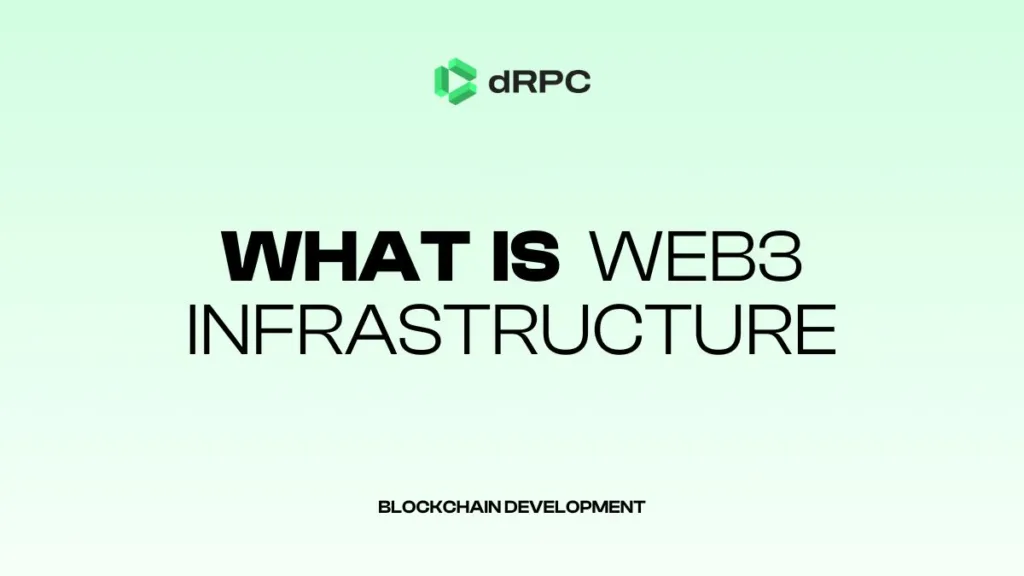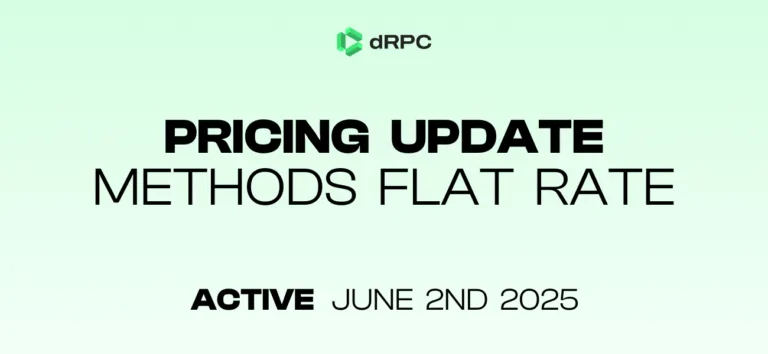Web3 infrastructure isn’t just another tech buzzword, it makes decentralized applications possible. As the internet evolves from centralized platforms to user-owned networks, robust blockchain infrastructure becomes the invisible backbone supporting this transformation.
For blockchain developers and projects alike, understanding the components of Web3 infrastructure becomes from good-to-know to must-know for building reliable, scalable applications. Without proper infrastructure, even the most innovative dApps can struggle with performance issues, unexpected outages, and poor user experiences.
This article explores what Web3 infrastructure is, why it matters, and how specialized providers like dRPC are solving critical challenges in this space. Whether you’re building your first dApp or scaling an established platform, the infrastructure you choose today will shape your project’s future.
Core Components of Web3 Infrastructure
| Component | Description | Importance |
|---|---|---|
| Blockchain Networks | Layer-1 chains (Ethereum) and Layer-2 solutions (Optimism) that provide consensus and execution environments | Foundation layer of all Web3 applications |
| RPC Endpoints | Gateways that allow reading blockchain state, submitting transactions, and querying data | Primary interface between applications and blockchains |
| Node Infrastructure | Physical or virtual servers that process requests, validate transactions, and maintain network state | Determines performance and reliability |
| Indexing Services | Tools that transform blockchain data into efficiently queryable formats | Makes blockchain data usable for applications |
| Testnet Faucets | Services providing test tokens for development environments | Enables testing before mainnet deployment |
The Shift from Web2 to Web3: Understanding the Transition
Web3 infrastructure represents a fundamental shift in how applications are built and deployed. Instead of relying on centralized servers and databases controlled by a handful of tech giants, Web3 moves toward a distributed architecture where applications run across decentralized networks.
This shift impacts several key aspects of application development:
- Trust assumptions: In Web2, users trust companies and their servers. In Web3, they trust code and networks.
- State management: Instead of centralized databases, state is distributed across blockchain nodes.
- Security models: Threats shift from server vulnerabilities to smart contract exploits and economic attacks.
- Scaling approaches: Horizontal scaling has different requirements when every computation has a cost.
These changes bring significant challenges. Blockchain networks weren’t originally designed for the performance demands of modern applications. Transaction finality takes time, RPC endpoints can become bottlenecks, and maintaining reliable connections across global user bases requires specialized infrastructure.
Key Components of Web3 Infrastructure
The essential components that make up modern Web3 infrastructure include:
1. Blockchain Networks: The Foundation Layer
At the base level are layer-1 blockchains like Ethereum or Solana, or Layer-2 blockchains like Optimism. These provide the consensus mechanisms and execution environments.
Each network makes different tradeoffs between decentralization, security, and performance. For instance, Optimism as layer-2 chain, leverages Ethereum’s security while improving throughput and reducing costs through its optimistic rollup design.
2. RPC Endpoints: Gateways to the Blockchain
Remote Procedure Call (RPC) endpoints are the primary interfaces between applications and blockchains. They allow developers to:
- Read blockchain state
- Submit transactions
- Listen for events
- Query historical data
The quality, reliability, and geographic distribution of these endpoints directly impact a dApp’s user experience. When an RPC endpoint experiences downtime or high latency, applications can become unusable, regardless of how well they’re designed.
3. Indexing and Query Services: Making Blockchain Data Usable
Blockchains store data in formats optimized for consensus, not for application queries. Indexing services transform this raw data into structured formats that can be efficiently queried by application frontends or backend services.
4. Faucets and Testing Infrastructure: The Development Pipeline
For testing and development environments, services like testnet faucets provide the resources developers need to prototype and validate their applications before deploying to mainnet.
5. Node Infrastructure: The Processing Power
Behind every RPC endpoint are actual blockchain nodes that process requests, validate transactions, and maintain network state. The quality, distribution, and resources allocated to these nodes determine the performance characteristics of the blockchain infrastructure service.
Why Infrastructure Providers Matter in Web3
While it’s technically possible for developers to run their own nodes, there are compelling reasons to leverage dedicated infrastructure providers:
Reliability at Scale
When a dApp suddenly gains popularity or gets featured in major publications, request volumes can spike by orders of magnitude within minutes. Scaling infrastructure to handle these surges requires significant expertise and resources.
Infrastructure providers like dRPC maintain geo-distributed clusters specifically designed to handle these traffic patterns. With over 2 billion requests processed daily across 7 global locations, we’ve already solved complex scaling problems so developers don’t have to.
Geographic Performance
Web3 is global by default. Users might access dApps from Tokyo, Berlin, São Paulo, or San Francisco, often simultaneously. Each millisecond of latency impacts user experience and can make complex dApps feel sluggish.
Geo-distributed infrastructure routes requests to the nearest available node, dramatically reducing latency compared to single-region deployments. dRPC’s network spans multiple continents, ensuring users get consistent performance regardless of their location.
Resource Efficiency
Running high-performance blockchain nodes requires significant computing resources and ongoing maintenance. For many projects, especially early-stage ones, allocating engineering time to infrastructure management isn’t the most efficient use of limited resources.
By leveraging shared or dedicated infrastructure services, development teams can focus on what truly differentiates their application: the user experience, smart contract logic, and product features.
Development Velocity
Every hour spent troubleshooting node synchronization issues or debugging RPC connection problems is time not spent building core product features. Infrastructure services streamline the development process, allowing faster iteration and deployment cycles.
Building on Reliable Infrastructure
Comprehensive infrastructure services like dRPC address these challenges through several key offerings:
Geo-distributed Public RPC
The foundation of reliable Web3 infrastructure starts with globally distributed RPC services. dRPC maintains clusters across 7 geographic regions, automatically routing requests to the nearest available node.
This architecture delivers several key benefits:
- High Availability: By distributing nodes across multiple regions and providers, the network maintains uptime even during regional outages.
- Low Latency: Users connect to the nearest geographic node, reducing round-trip times for RPC requests.
- Load Balancing: Traffic is automatically distributed across the network, preventing any single node from becoming a bottleneck.
- Failover Protection: If a node becomes unresponsive, requests are instantly rerouted to healthy alternatives.
For applications with users across multiple regions, this approach eliminates the need to maintain separate infrastructure for different geographic markets.
Dedicated Commercial Nodes
While public RPC endpoints work for many applications, projects with high-volume requirements or specialized needs often benefit from dedicated infrastructure.
Dedicated nodes provide:
- Guaranteed Resources: No competition with other applications for node resources, ensuring consistent performance even during network congestion.
- Customized Configuration: Nodes optimized for specific workloads, whether that’s high read throughput, transaction processing, or event monitoring.
- Enhanced Security: Isolated environments reduce attack vectors compared to shared infrastructure.
- SLA Guarantees: Formal uptime and performance commitments backed by service level agreements.
Many teams initially build on public infrastructure only to hit performance walls as they scale. The transition to dedicated nodes can be disruptive if not planned in advance, so considering growth trajectories early can prevent significant challenges later.
Testnet Faucets
Development and testing environments are critical to the Web3 development workflow. Testnet faucets simplify the process of obtaining test tokens, streamlining the development cycle.
These services:
- Let’s developers to get testnet tokens for deploying and testing apps on testnet
- Simplify onboarding for new team members
- Enable continuous integration testing
- Support community developers building on protocols
Real-World Infrastructure Considerations for Web3 Projects
Based on experience from successful Web3 applications, here are practical considerations when designing an infrastructure approach:
1. Plan for Multi-Region From Day One
Even if initially targeting users in a specific region, Web3 applications tend to find audiences globally. Designing architecture to leverage geo-distributed infrastructure from the beginning prevents the need for significant refactoring later.
2. Implement Request Redundancy
Relying on a single RPC endpoint or provider creates a single point of failure. Client-side fallback mechanisms can seamlessly switch between endpoints when performance degrades or connections fail.
// Example of RPC redundancy implementation
const providers = [
new ethers.providers.JsonRpcProvider('https://optimism.drpc.org'),
new ethers.providers.JsonRpcProvider('https://backup-provider.example.com'),
// Additional fallbacks...
];
async function getRedundantProvider() {
for (const provider of providers) {
try {
// Test provider with a simple call
await provider.getBlockNumber();
return provider;
} catch (error) {
console.warn(`Provider failed health check: ${error.message}`);
// Try next provider
}
}
throw new Error('All providers failed');
}3. Monitor RPC Performance
Setting up monitoring for RPC connections helps identify issues before they impact users. Key metrics to track include:
- Request latency
- Error rates by method type
- Request volume by region
- Cache hit rates (if applicable)
4. Consider Hybrid Architecture
Not everything needs to be on-chain. A hybrid architecture that leverages blockchain for critical operations while using traditional infrastructure for less sensitive functions often provides the best balance of performance and decentralization.
5. Scale Infrastructure With User Growth
Starting with shared infrastructure minimizes costs, but establishing clear triggers for upgrading to dedicated resources is important. These might include:
- Consistent RPC request volumes above certain thresholds
- User growth in specific geographic regions
- Launch of features requiring specialized node configurations
Future Trends in Web3 Infrastructure
The Web3 infrastructure landscape continues to evolve. Key trends to watch include:
Multichain Access
Zero-Knowledge Infrastructure
ZK-rollups and ZK-proofs are enabling new scaling paradigms, but they require specialized infrastructure to generate and verify proofs efficiently. This emerging category of infrastructure will become increasingly important as ZK technology matures.
AI-Enhanced Node Operations
Machine learning is beginning to impact node operations through predictive scaling, anomaly detection, and optimized request routing. These technologies promise to further improve reliability while reducing infrastructure costs.
Decentralized RPC Networks
While many current infrastructure providers use centralized architectures, there’s movement toward more decentralized RPC networks that distribute requests across independent node operators while maintaining performance guarantees.
Infrastructure as Competitive Advantage
In the early days of Web3, simply getting a dApp to work was an achievement. Today, with billions daily RPC requests flowing through providers like dRPC, the bar has been raised. Users expect applications to be responsive, reliable, and accessible globally.
The right infrastructure isn’t just about keeping applications running, it’s about creating space for innovation. When development teams aren’t worrying about node synchronization issues or regional performance problems, they can focus on building features that truly differentiate their products.
Whether launching a first dApp or scaling to millions of users, the foundation built upon matters. With geo-distributed networks, dedicated nodes when needed, and access to an active developer community, services like dRPC provide the infrastructure backbone that lets teams focus on what matters most: building the future of Web3.
FAQ for buidlers
Q: How do you choose between public RPC endpoints and dedicated nodes?
Start with public endpoints during development and early launch phases. Consider upgrading to dedicated nodes when consistently seeing more than 100 requests per second, experiencing latency issues during peak hours, or having specialized requirements like archive node access or custom rate limits.
Q: What should you look for in a Web3 infrastructure provider?
Key factors include geographic distribution (more regions generally means better global performance), supported networks, reliability guarantees, scaling capabilities, and support responsiveness. Providers like dRPC that offer 24/7 dedicated support can be crucial when troubleshooting time-sensitive issues.
Q: How can you optimize dApps to reduce infrastructure costs?
Implement client-side caching for frequently accessed data, batch RPC requests where possible, use WebSockets for subscription-based updates rather than polling, and consider indexing solutions for complex queries rather than relying solely on RPC calls.
Q: Are there security considerations when using shared infrastructure?
Yes. Avoid sending private keys or sensitive data through RPC requests, implement rate limiting on the application layer to prevent DoS attacks, use TLS for all connections, and consider dedicated nodes for applications handling significant value or sensitive operations.
Q: How do you test a dApp’s resilience to infrastructure failures?
Implement chaos testing by randomly disabling RPC endpoints in development environments, simulate high-latency conditions, and test application behavior when partial responses are received.
Q: Which blockchains does dRPC currently support?
dRPC supports multiple networks, for example: Ethereum, Optimism, Arbitrum, Base, Zircuit, and others. Check the chainlist for all supported chains.





